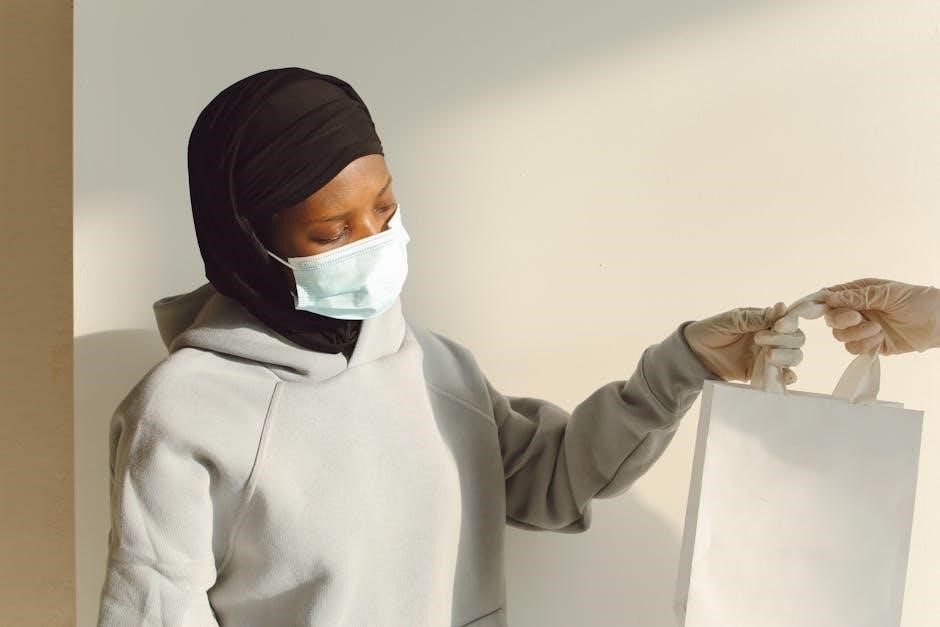After CABG surgery, patients must follow
sternal precautions
to prevent complications and promote healing, using proper techniques for daily activities, as outlined in medical guidelines and research studies available online.
Definition and Purpose
Sternal precautions are guidelines provided to patients after undergoing coronary artery bypass grafting (CABG) surgery to prevent complications and promote healing. The purpose of these precautions is to minimize the risk of sternal instability, infection, and other post-operative complications. By following these guidelines, patients can reduce the risk of sternal complications!
According to medical research, sternal precautions play a crucial role in the recovery process of patients who have undergone CABG surgery. The definition of sternal precautions includes a set of instructions and guidelines that patients must follow to ensure proper healing and prevent complications.
These precautions are designed to protect the sternum and surrounding tissues, allowing them to heal properly and reducing the risk of post-operative complications. By understanding the definition and purpose of sternal precautions, patients can take an active role in their recovery and ensure a smooth and successful healing process.
The importance of sternal precautions cannot be overstated, as they are a critical component of the post-operative care plan for CABG patients.
Importance of Sternal Precautions after CABG
The importance of sternal precautions after CABG surgery cannot be overstated, as they play a crucial role in preventing post-operative complications. By following these precautions, patients can reduce the risk of sternal instability, infection, and other complications that can prolong recovery time.
According to medical research, sternal precautions are essential for promoting proper healing and preventing complications after CABG surgery. The sternum is a critical part of the chest cavity, and any instability or infection can have serious consequences for the patient’s health.
By adhering to sternal precautions, patients can minimize the risk of these complications and ensure a smooth and successful recovery; The importance of sternal precautions after CABG surgery is evident in the medical literature, and patients should be aware of the potential risks and benefits of following these guidelines.
Overall, the importance of sternal precautions after CABG surgery is clear, and patients should prioritize these guidelines to ensure a successful recovery.

Activities of Daily Living (ADLs) with Sternal Precautions
Patients follow specific guidelines for daily activities like bathing and dressing using proper techniques.
Getting into and out of Bed
To get into bed, patients should sit on the edge of the bed and then swing their legs into the bed, avoiding bending or twisting.
Using a pillow for support can help reduce strain on the chest.
When getting out of bed, patients should roll onto their side and use their arms to help push themselves up, keeping their chest stable.
It is essential to avoid heavy lifting, bending, or straining, as these movements can put pressure on the sternum and disrupt the healing process.
Patients should also avoid crossing their legs or ankles, as this can cause them to twist and put unnecessary strain on their chest.
By following these guidelines, patients can reduce their risk of complications and promote a smooth recovery.
Proper techniques for getting into and out of bed are crucial for patients following sternal precautions after CABG surgery.
Patients should always prioritize their safety and comfort when performing daily activities.
This will help them recover quickly and effectively.
Standing up from a Chair or Toilet
When standing up from a chair or toilet, patients should use their arms to help push themselves up, keeping their back straight and avoiding straining their chest.
This can help reduce the risk of complications and promote a smooth recovery.
Patients should also avoid bending or twisting, as these movements can put pressure on the sternum and disrupt the healing process.
Using a chair with armrests or a toilet with a raised seat can provide additional support and make it easier to stand up.
Patients should take their time and move slowly when standing up, as rushing can increase the risk of injury.
It is essential to prioritize safety and comfort when performing daily activities, such as standing up from a chair or toilet.
By following these guidelines, patients can reduce their risk of complications and promote a successful recovery.
Proper techniques for standing up from a chair or toilet are crucial for patients following sternal precautions after CABG surgery, and can help them regain their independence and confidence.
Getting Dressed with Sternal Precautions
Getting dressed with sternal precautions requires careful consideration to avoid putting strain on the chest.
Patients should choose loose, comfortable clothing that is easy to put on and take off, such as shirts with magnetic closures or zip-ups.
It is recommended to dress from the bottom up, starting with pants or a skirt, to minimize bending and straining.
Patients should avoid lifting their arms above their head or stretching to put on clothes, as this can put pressure on the sternum.
Instead, they can use a reacher or ask for assistance from a caregiver.
Using a dressing stick or other adaptive equipment can also make it easier to get dressed while following sternal precautions.
Patients should take their time and move slowly when getting dressed, as rushing can increase the risk of injury.
By following these guidelines, patients can get dressed safely and comfortably while promoting a successful recovery from CABG surgery.
Proper dressing techniques are essential for patients to maintain their independence and confidence during the recovery period.

Physical Therapy and Recovery
Physical therapy plays a crucial role in rehabilitation, helping patients regain strength and mobility after surgery, with supervised exercises and activities.
Progressing to Sitting and Walking
Progressing to sitting and walking is a crucial part of the recovery process after CABG surgery. With the assistance of a nurse or physical therapist, patients can begin to sit in a chair and walk to the bathroom. This helps to improve circulation, strengthen muscles, and promote overall healing. A physical therapist will work with the patient to develop a personalized exercise plan, including activities such as walking, to help them regain strength and mobility. It is essential to follow the therapist’s instructions and take regular breaks to avoid fatigue; As the patient progresses, they can begin to walk longer distances, eventually walking several times a day. This progress is a significant milestone in the recovery process, and patients should be proud of their achievements. By following the recommended exercises and activities, patients can ensure a safe and successful recovery. Regular monitoring and feedback from healthcare professionals are also vital.
First Walk and Daily Walking Routine
The first walk after CABG surgery is a significant milestone, marking the beginning of a daily walking routine. A physical therapist will assist the patient with their first walk, providing guidance and support. The therapist will help the patient to stand up from a chair or bed, and walk to the bathroom or a short distance. This initial walk is crucial in helping the patient to regain confidence and mobility. As the patient progresses, they will be encouraged to walk longer distances, gradually increasing the duration and frequency of their walks. A daily walking routine will be established, with the patient aiming to walk several times a day. This routine will help to improve circulation, strengthen muscles, and promote overall healing. The patient’s progress will be monitored, and adjustments will be made to the walking routine as needed. The goal is to help the patient to return to their normal activities, while minimizing the risk of complications.

Duration and Restrictions of Sternal Precautions
Patients must follow sternal precautions for six to eight weeks after CABG surgery to ensure proper healing.
Restrictions for Six to Eight Weeks
Patients are advised to follow specific restrictions for six to eight weeks after CABG surgery to ensure proper healing of the sternum. These restrictions include avoiding heavy lifting, bending, or strenuous activities that may put strain on the chest. It is also recommended to avoid driving or operating heavy machinery during this period. Additionally, patients should avoid lifting objects that weigh more than 5 pounds and should not push or pull heavy objects. They should also avoid bending or twisting, and should not sleep on their stomach. By following these restrictions, patients can help prevent complications and promote healing of the sternum. It is essential to follow the instructions provided by the healthcare provider and to attend follow-up appointments to monitor the healing progress. Patients should also be aware of the signs of complications, such as chest pain or difficulty breathing, and should seek medical attention immediately if they experience any of these symptoms.

